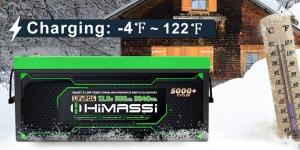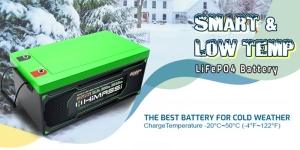Low temperature LiFePO4 battery VS normal LiFePO4 battery
LiFePO4 batteries make them highly suitable for a wide array of applications, positioning them as a reliable and sustainable choice in the global shift towards greener energy solutions.
Features of Low-Temperature LiFePO4 Batteries
Low temperature LiFePO4 batteries are engineered to perform optimally in conditions where most other batteries falter—extreme cold. Designed with unique electrolyte formulations and enhanced internal architecture, these batteries can operate effectively at temperatures as low as -40°C. This capability is critical for applications in geographically cold regions or in specialized sectors such as aerospace, where equipment must function reliably in harsh conditions without frequent maintenance.
Himax’s low-temperature LiFePO4 batteries are equipped with built-in heating systems. These systems are powered by a small portion of the battery’s own energy to warm up the battery to an optimal operational temperature before starting the discharge process. This feature ensures that the battery can deliver adequate power upon demand and extends its usable life by preventing the stresses associated with operating in cold conditions.
In order to protect your low-temperature LiFePO4 battery in cold weather, its temperature needs to be kept above 1.6°C. Start our heated battery system and you can rest assured that the internal temperature of the battery will never drop below freezing. Our deep-cycle LiFePO4 heating batteries feature proprietary low-power technology that keeps the battery at optimal temperature and ready to be recharged.

Performance of Normal LiFePO4 Batteries
Normal LiFePO4 batteries are designed to operate within a more standard temperature range, typically from about 0°C to 50°C. Within this spectrum, they exhibit optimal performance, making them suitable for most residential, commercial, and industrial applications under typical environmental conditions.
These batteries are known for their robustness, consistent power output and high efficiency across their charge and discharge cycles. Under normal operating temperatures, LiFePO4 batteries boast a stable voltage output, which is crucial for devices that require a consistent energy supply to function properly. This stable discharge curve ensures that devices do not experience power dips and can operate at peak efficiency until the battery is nearly depleted.
However, when temperatures drop below freezing, the performance of standard LiFePO4 batteries can start to wane. The chemical reactions responsible for generating electricity slow down significantly, resulting in reduced ionic conductivity. This slowdown can lead to decreased energy efficiency, slower charging rates, and reduced overall power output. Such conditions are not ideal for applications that require high reliability in cold weather, such as outdoor security systems in northern climates or any technology deployed in unheated areas during winter.
Furthermore, while normal LiFePO4 batteries perform adequately in mild to warm conditions, extreme heat can also challenge their capabilities. High temperatures can accelerate chemical degradation within the battery, potentially shortening its overall lifespan and affecting performance characteristics like energy density and charge retention.
Despite these temperature sensitivities, normal LiFePO4 batteries remain a popular choice due to their overall value proposition—balancing cost, performance, and longevity effectively for most applications not subject to extreme conditions.
Performance Comparison between Low Temperature and Normal Batteries
When evaluating low-temperature LiFePO4 batteries against their normal counterparts, the primary distinction lies in their operational efficiency under different thermal conditions. This comparison is crucial for users whose applications demand reliable battery performance in environments that regularly experience extreme temperatures.
- Efficiency at Low Temperatures:
- Low-Temperature Batteries: These are specifically engineered to maintain high levels of efficiency in cold environments. With specialized electrolyte formulations and internal heating systems, low-temperature LiFePO4 batteries can operate effectively at temperatures as low as -40°C. They manage to keep their internal resistance low, which ensures that energy delivery remains stable even in the cold.
- Normal Batteries: In contrast, normal LiFePO4 batteries experience a drop in performance as the temperature falls below 0°C. The internal resistance increases, leading to slower charge times and reduced power output, which can be problematic for devices that depend on a consistent energy supply.
- Energy Density and Output Consistency:
- Low Temperature Batteries:Despite the extreme cold, these batteries can deliver close to their optimal energy density, making them suitable for critical applications in remote or harsh environments.
- Normal Batteries: At standard operational temperatures, these batteries provide excellent energy density and output consistency. However, in colder settings, their energy density decreases, impacting the overall device performance.
- Longevity and Durability:
- Low-Temperature Batteries: These batteries are not only built to perform under cold conditions but also designed to withstand the thermal stress associated with such environments, potentially extending their operational lifespan.
- Normal Batteries: While robust under normal conditions, their lifespan can be compromised in extreme cold or heat, as these conditions accelerate degradation processes.
- Cost-Effectiveness:
- Low-Temperature Batteries: Typically more expensive due to their specialized design and additional features like built-in heaters, these batteries are cost-effective for applications where failure due to temperature is not an option.
- Normal Batteries:More affordable and sufficient for most common applications, making them a cost-effective choice for everyday uses that do not encounter severe temperatures.
In summary, the choice between low temperature and normal LiFePO4 batteries should be guided by the specific environmental conditions and performance requirements of the intended application. Low temperature batteries offer critical advantages in cold climates, ensuring reliability where normal batteries might falter.
Application Scenario Analysis
The selection between low-temperature and normal LiFePO4 batteries should be influenced by the specific operational demands and environments they will encounter. Here’s a detailed look at the practical applications of each type:
- Low Temperature LiFePO4 Batteries:
- Extreme Climate Expeditions: Ideal for use in polar expeditions or high-altitude treks where temperatures can plummet drastically. The ability of these batteries to operate effectively in such conditions ensures that critical equipment such as GPS devices, communication gear, and medical supplies remains operational.
- Cold Storage Facilities: In industries where goods need to be stored at low temperatures, such as in food processing or pharmaceuticals, low-temperature batteries ensure that monitoring and logistic equipment function reliably, maintaining the integrity of the cold chain.
- Outdoor Equipment in Cold Regions: For infrastructure located in cold regions, including renewable energy setups like solar panels or wind turbines, these batteries provide the necessary resilience to maintain power supply despite frigid temperatures.
- Normal LiFePO4 Batteries:
- Residential Energy Storage:Perfect for home energy storage systems, particularly those integrated with solar panels, as they offer stability and long life under typical environmental conditions.
- Electric Vehicles and Personal Electronics: These batteries are suitable for areas with mild climates where extreme temperature fluctuations are rare. They provide the optimal balance of performance, cost, and longevity for daily use in consumer electronics and electric vehicles.
- Backup Power Systems: In commercial and industrial settings not exposed to extreme temperatures, normal LiFePO4 batteries serve as reliable backup power sources due to their excellent safety profile and long cycle life.
Choosing the Right Battery:
- Assessing Environmental Conditions: Users must consider the usual and extreme temperature conditions of their operating environment. Where temperatures regularly drop below freezing, low-temperature batteries are essential.
- Considering Operational Demands:For applications where battery failure can result in significant operational or safety risks, investing in low temperature technology may be prudent, despite the higher initial cost.
- Evaluating Long-Term Costs: While normal LiFePO4 batteries are more cost-effective upfront, the potential costs associated with battery failure in unsuitable conditions should not be overlooked. The longevity and reliability of low-temperature batteries may offer better value over time in harsh climates.
In each scenario, the key to optimal battery selection lies in understanding the specific energy demands and environmental challenges of the application. This strategic approach ensures that the chosen battery not only meets current needs but also offers durability and reliability throughout its lifespan.

About Himax Electronics
Himax Electronics stands at the forefront of battery technology innovation, specializing in the development and manufacturing of LiFePO4 batteries tailored for a wide range of applications. As a leader in the industry, we are dedicated to advancing battery solutions that meet the rigorous demands of both commercial and industrial environments.
Innovative Product Line:
- At Himax Electronics, our product range is extensive, featuring everything from standard LiFePO4 batteries to specialized low-temperature models designed for extreme conditions. Each product is engineered with precision, incorporating cutting-edge technology to ensure top performance and reliability.
Commitment to Quality and Safety:
- Quality assurance is paramount at Himax Electronics. We adhere to strict international standards to ensure each battery not only meets but exceeds industry safety and performance benchmarks. Our rigorous testing procedures guarantee that our batteries deliver longevity and consistency in all operational contexts.
Custom Solutions and Technical Support:
- Understanding that each client has unique needs, we offer customized battery solutions tailored to specific applications. Our expert team provides comprehensive technical support, assisting with everything from system design to post-installation troubleshooting, ensuring optimal performance and satisfaction.
Environmental Responsibility:
- Committed to sustainability, Himax Electronics focuses on eco-friendly practices throughout our production processes. Our batteries are designed to be both energy-efficient and recyclable, minimizing environmental impact while maximizing performance.
Engagement and Accessibility:
- We believe in keeping our clients informed and supported. Himax Electronics maintains an open line of communication through our customer service, detailed documentation, and accessible technical resources. Whether you are integrating a new energy system or upgrading an existing one, our professionals are here to provide expert guidance and support.
Himax Electronics is not just a provider but a partner in your energy journey. We invite you to explore our range of products and discover how our batteries can enhance your applications. For more information, visit our website or contact our customer service team. Let us help you achieve success with the best battery technology.



